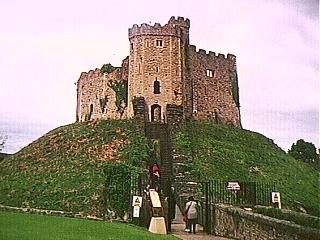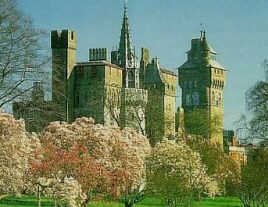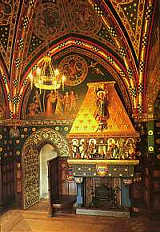Cardiff Castle
The Castle in the centre of Cardiff is one of Wales's leading tourist attractions. Situated in the very heart of the capital, alongside city centre shopping and the magnificent Bute Park, the Castle's enchanting fairytale towers conceal an elaborate and splendid interior. Contained within its mighty walls is a history spanning nearly 2,000 years, dating from the coming of the Romans in the first century AD.
Cardiff in the mid first century AD was a site of strategic value, sitting along the main link between Caerleon and Carmarthen. The Romans initially constructed a 10-acre fort on the spot where the castle now sits. Inside the walls would have been barracks, workshops, stores and other essential buildings. Three successive forts were built by the Romans and the Roman ruins were not uncovered until the 1800's.

In 1093, after the Norman Conquest, a castle was built by Robert Fitzhamon, Lord of Glocester, one of William the Conqueror's favoured followers, on the ruins of the Roman fortification. It is an outstanding example of the classic motte and bailey fortification, the motte being topped by a wooden fort. In the 12th century, the castle's lord, Robert "the Consul" (the natural son of Henry I ordered the construction of a twelve sided stone keep. A band of red stone separates the Roman and Norman stonework. The keep survives in fine condition, the only significant additions being its 15th century gatehouse and stairway. The eldest son of William the Conqueror, Robert, 2nd Duke of Normandy, was held captive at the castle by his youngest brother Henry I, and died here in 1134.
Much of Cardiff Castle's history revolves around conflicts with the native populace. In 1183-84 the Welsh revolted, and caused much damage to the castle and its associated town. Even though the powerful de Clare family took hold of the castle in the next century, problems persisted with Welsh insurgency. In the 1270's, when Wales was unified under the leadership of the charismatic Welshman, Llywelyn ap Gruffydd, Gilbert de Clare refortified the castle in anticipation of further Welsh rebellion. The curtain wall was strengthened and construction of the Black Tower and south gateway was initiated. The much awaited assault never occurred and de Clare's work remains in solid repair to this day.
In 1306, the castle passed to Britain's notorious Despenser family and remained their possession for almost 100 years. Conflict (and not just with the Welsh) was the Despenser strong point. In 1321, the Despenser castle at Cardiff was besieged and captured by neighboring marcher lords who sought to overthrow their pathetic king, Edward II. A vocal supporter of the king, Hugh le Despenser was assessed as an interloper with unfair access to the monarchy. In 1326, the marcher lords attained their goal: Edward II was imprisoned (and brutally murdered the following year), and Hugh le Despenser was hanged at Hereford.

During the rebellions of Owain Glyndwr in the earliest years of the 15th century, the Welsh savagely assaulted Cardiff Castle and set the town on fire. However, the Despensers retained control of the castle until 1414, when the rights to Cardiff's castle passed to the husband of the last Despenser heir, Isabel. Passing shortly thereafter to the widowed Isabel's second husband, the castle became the possession of another influential family, the Beauchamps, earls of Warwick. Richard Beauchamp was responsible for the construction of new buildings at Cardiff Castle, including residential quarters along the western curtain wall and the impressive Octagon Tower.
As tutor to the infant king Henry VI, Richard Beauchamp travelled with his charge to France, and died there in 1445. Richard's daughter, Ann, received Cardiff Castle as part of her inheritance, and her husband, Richard Neville, became its new lord. Neville later became known as "Warwick, the King-Maker" for his extreme influence in the affairs of State. After the King-maker's death in 1471, the fortress at Cardiff passed first to his eldest daughter, another Isabel, and then to her sister, Ann (whose husband, Richard, Duke of Gloucester, became King Richard III in 1483). Upon King Richard's defeat by Henry VII, founder of the formidable Tudor dynasty, Cardiff Castle was granted to the new king's well-respected uncle, Jasper. With the exception of a brief time when Ann Beauchamp regained possession of the castle, it belonged to the monarchy for the next 75 years.
In 1550, William Herbert, member of one of Britain's most powerful medieval families (and brother of Henry VIII's last wife, Catherine Parr), obtained control of Cardiff Castle. During the English Civil War the Herberts sided with their king, Charles I, offering him refuge at the castle in the summer of 1645. Cardiff Castle was a prize sought by both sides of the struggle, the Royalists and Parliamentary forces, but it was eventually taken by Oliver Cromwell's army. In 1776, the last Herbert heir, Charlotte Jane, passed the estates to her husband John Stuart, soon to become the Earl of Bute. His son, the 2nd Marquess of Bute was responsible for turning Cardiff into one of the world's greatest coal exporting ports.

The Castle and the Bute fortune passed to his son John, the 3rd Marquess, who by the 1860s was reputed to be the richest man in the world. Between 1867 and 1881 the 3rd Marquess of Bute employed the architect William Burgess to construct an ornate mansion on the site. Burgess created a great palace in the style of a medieval castle with gothic towers. The rooms were designed with lavish and opulent interiors, rich with murals, stained glass, marble, gilding and elaborate wood carvings. Each breathtaking room has its own special theme, including Mediterranean gardens, and Italian and Arabian decoration. The Banqueting Hall, the largest room, has a splendid wooden roof decorated with brightly coloured shields and walls painted with murals depicting scenes from the Civil War. In 1948 the castle was presented in trust to the city of Cardiff. As well as visiting the spectacular interiors, visitors can enjoy the Castle grounds, where peacocks, ducks and geese wander freely.